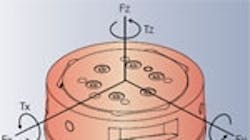Force/torque sensors
A force/torque sensor is a transducer that measures and outputs forces and torques. Six-axis units (also called multi-axis force/torque and F/T transducers) measure all three Cartesian coordinates: X, Y, and Z. These transducers react to applied forces and torques as described by Newton's third law: To every action there is always opposed an equal reaction — and the mutual action of two bodies upon each other are always equal, and directed to contrary parts.
The monolithic transducers we discuss here, machined from solid pieces of hardened steel, are useful for measuring these forces because their beams are part of one solid structure, which decreases hysteresis and increases strength and repeatability.
Q&A
What forces should be considered when selecting a F/T sensor?
Moment capacity is usually the determining factor. The end effector attached to the transducer, as well as the tasks being performed, generate forces on the transducer, which result in a moment. This moment is the applied force (dynamic and static) multiplied by the distance from the transducer origin to the point at which the force is applied.
What can affect transducer performance?
Proper sizing affects performance. Let's say that an application's expected maximum measured load is 98 N (10 kg) of force and the end-effector is 25 cm long. The moment generated is 24.5 Nm. The best sensor for this application should be able to handle this 24.5 Nm moment, as well as the maximum single-axis moment rating to withstand overload situations. Here, particular attention should be paid to dynamic loads caused by robot acceleration and deceleration: These forces can be many times the value of static forces during high acceleration or deceleration.
Resolution is also important. A fine resolution requirement can conflict with a transducer chosen for moment capacity, because some transducers with larger ranges have coarser resolutions.
In transducers where the beams are not isolated but mechanically coupled to multiple axes, applied loads are shared with the other beams, which increases the sensing range in a given axis if a counterpart axis is less loaded. The best resolution occurs when the quantization of the gauges is evenly distributed as load is applied; the worst occurs when the discrete value of all involved gauges increases simultaneously. Typical applications are somewhere between these two.
F/T resolutions are often expressed as the average of worst and best-case scenarios — which reflects typical transducer performance and gives a close (and conservative) estimate.
Are there other considerations?
Transducer cable must be routed so that it is not stressed, pulled, kinked, or cut anywhere through the range of motion. Some new transducers feature improved, shielded high-flex cable connections for better strain relief. These are useful in ankle joints of humanoid robots, which could provide personal assistance for the sick and elderly, and in dirty and dangerous jobs, such as cleaning toxic waste in nuclear power plants, and defusing bombs. Here, the transducers send force feedback to control robot motion.
This month's handy tips provided by ATI Industrial Automation, Inc. For more information, call (919) 772-0115 or visit www.ati-ia.com.
